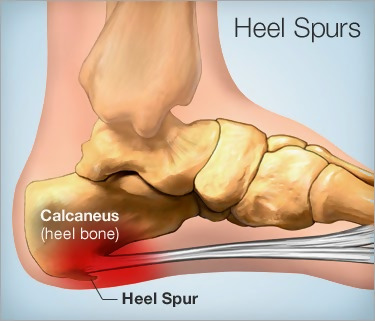Heel spur is a disease that is caused due to deposition of excessive calcium which leads to a bony protrusion on the underside of the heel bone. An x-ray report can show a bony extension near the heel bone. Without the evidence of an x-ray report, the condition is termed as heel spur syndrome. Generally, heel spurs are painless but they can cause intense heel pain and pain while walking or any kind of leg movement. Heel spur often leads to plantar fasciitis. Heel spurs can be healed by exercise, medications, customized orthotics and cortisone injections. Surgery might be necessary if these treatments fail.

Causes of heel spur:
Heel spurs are caused due to the accumulation of calcium deposits on the underside of the heel bone. These conditions develop over a large period of a couple of months. The situation of heel spurs can also be caused due to
- strains on foot muscle and ligaments
- stretching of the plantar fascia
- Repeated tearing of the membrane covering the heel bone.
Heel spurs develop in patients who are athletes. People performing athletic activities that involve running and jumping are often affected by heel spurs.
The risk of developing heel spur increases due to these following factors:
- Walking gait abnormalities, which causes to place excessive stress on the heel bone, ligaments, and nerve near the heel
- Running or jogging on hard surfaces
- Poor-fitting shoes or if the shoes are worn in the wrong way. The shoes especially which lack proper arch support increases the risk of causing heel spur.
- Excess weight
- Obesity
Symptoms of heel spurs:
There are no distinct symptoms for heel spur. But the development of heel spur can be assumed if we can feel chronic heel pain, especially while walking, jogging, running, or any leg movements. Another symptom is if inflammation is developed at the point of the spur formation.
Treatments:
Rest does not really help to recover pain to give heel spurs pain relief. You can feel a sharp pain as soon as you wake up from the bed. Regular walking helps in decreasing the pain. But there can be a recurrence of pain after prolonged walk or rest.
If the pain persists, consult a doctor. He will most probably prescribe:
- Stretching exercises
- Special shoe recommendations
- Taping or strapping to rest stressed muscles and tendons.
- Shoe inserts or orthotic devices.
- Physical therapy
- Night splints
Heel spur pain may also give a positive response to treatment involving medications such as acetaminophen (Tylenol), ibuprofen (Advil) or naproxen (Aleve). If shoe inserts are not working, cortisone injections are given to relieve the inflammation caused due to the heel pain.
If these methods and medications are still not able to improve the condition, the foot doctor at DeNiel Foot and Ankle Center might suggest a surgery
If you have any questions, please feel free to contact our office located in Houston, TX. We offer the newest diagnostic and treatment technologies for all your foot and ankle needs.


Comments
[…] for high heels, has admitted that her longtime habit of wearing Manolos caused her to develop bone spurs and […]